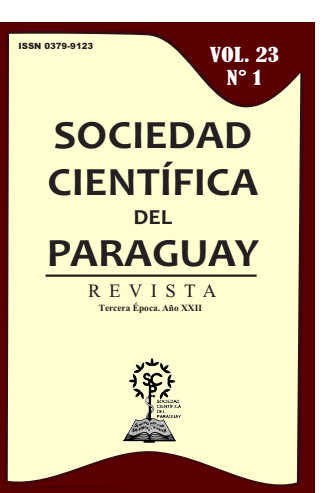Land use changes and its impact on the hydrological cycle in the Ñacunday River Basin (Upper Paraná Atlantic Forest)
DOI:
https://doi.org/10.32480/rscp.2018-23-1.107-122Keywords:
Ñacunday River, Water Balance, change of land usesAbstract
The goal of this investigation is to study the responses at low frequencies that could be generated from the relationship between precipitation, evapotranspiration and runoff, as a consequence of changes in land use in the Ñacunday river basin. In order to analyze the effect of these changes on the water balance, the Singular Spectral Analysis method is applied to the historical series of precipitations (P), water flows (Q) and evapotranspiration (ET)
Remote sensing is used to determine the loss of the Upper Paraná Atlantic Forest in the basin where it was found that the greatest losses of forest cover occurred in the 80s with a 46.6% decrease and in the decade of the 90 the loss was 24.8%
Coincidentally in the 1980-2000 period, Q increases of up to 50% were recorded, with P being responsible for only 20% of the Q increases. The ET determined from the water balance also reflected deforestation
Metrics
Downloads
References
2. Bosch JM, Hewlett JD. A review of catchment experiments to determine the effect of vegetation changes on water yield and evapotranspiration. Journal of Hydrology. 1982;55:2-23.
3. Bruijnzeel LA. Hydrology of moist tropical forests and effects of conversion: A state of knowledge review. Ginebra, Holanda: IHP-IAHS-UNESCO; 1990.
4. Olson DM, Dinerstein E. The Global 200: A Representation Approach to Conserving the Earth’s Distinctive Ecoregions. Conservation Science Program. World Wildlife Fund. US; 1998.
5. Olson DM, Dinerstein E, Wikramanayake ED, Burgess ND Powell GVN, Underwood EC, D’Amico JA. Terrestrial ecoregions of the world: A new map of life on Earth. BioScience. 2001;51(11):933-938.
6. Di Bitetti MS, Placci G, Dietz LA. Una visión de biodiversidad para la ecorregión del Bosque Atlántico del Alto Paraná. Washington, D.C. World Wildlife Fund; 2003.
7. Braga B, Tucci CEM, Souza Filho FA, Marengo JA, Molion LB, Clarke RT. Clima e recursos hídricos no Brasil. Porto Alegre: ABRH; 2003.
8. Leite C.C., Costa M.H., Soare-Filho B.S., Hissa L.B.V. Historical land use change and associated carbon emissions in Brasil from 1940 to 1995. Global Biogeochemical Cycle. 2012;26:13-21.
9. Huang C, Kim S, Altstatt A, Townshend JRG, Davis P, Song K, Tucker CJ, Rodas O, Yanosky A, Clay R, Musinsky J. Rapid loss of Paraguay's Atlantic forest and the status of protected areas -A Landsat assessment. Remote Sensing of Environment. 2012;106:460-466.
10. Tucci CEM, Clarke RT. Environmental issues in the la Plata Basin. Water Resources Development. 1998;14:157-173.
11. Krepper CM, Venturini V. Assessing interannual water balance of La Plata river basin. Atmósfera. 2009;22(4):387-398.
12. Doyle ME, Barros VR. Attribution of the river flow growth in the Plata basin. International Journal of Climatology. 2011;31(15):2234-2248.
13. Wehrle A, Venturini V, Jobbagy E. Cambios de uso de la tierra y su impacto en el ciclo hidrológico en la Región Bosque Atlántico del Alto Paraná (Cuenca del Plata). Santa Fe; 2016.
14. García N, Mechoso CR. Variability in the discharge of South American rivers and in climate. Hydrological Sciences Journal. 2005;50(3):458- 478.
15. Krepper CM, García NO, Jones PD. Low-frequency response of the upper Paraná basin. International Journal of Climatology. 2008;28(3):351-360.
16. Collischonn W, Tucci C, Clarke RT. Further evidence of changes in the hydrological regime of the River Paraguay: part of a wider phenomenon of climate change? Journal of Hydrology. 2001;245(1):218-238.
17. Antico A, Schlotthauer G, Torres ME. Análisis de la variabilidad hidro-climática de la cuenca del Paraná mediante un nuevo método de descomposición modal empírica. Memorias del II Congreso Internacional de Hidrología de Llanuras. Santa Fe, Argentina; 2014.
18. Allen MR, Smith LA, Monte Carlo SSA. Detecting irregular oscillations in the presence of coloured noise. J. Clim. 1996;9:3373–3404.
19. Brutsaert W. Hydrology. An Introduction. New York: Cambridge University Press; 2005.
20. Vautard R, Ghill M. Singular spectrum analysis in non-linear dynamics with applications to paleoclimatic time series. Physica D. 1989;35:395-424.
21. Ghill M, Vautard R. Interdecadal oscillation and the warming trend in global temperature time series.Nature.1991;359:324–327.
22. Vautard R. Patterns in time: SSA and MSSA. In: von Storch H, Navarra A, editors. Analysis of climate variability: applications of statistical techniques. Berlin: Springer Verlag; 1995, p. 23-38.
23. Golyandina N, Nekrutkin V, Zhigljavsky A. Analysis of time series structure: SSA and related techniques. Monographs on Statistical and Applied Probability 90. Boca Raton, Florida: CRC Press; 2001.
24. Paluš M, Novotná D. Quasi-Biennial Oscillations extracted from the monthly NAO index and temperature records are phase-synchronized. Nonlinear Processes in Geophysics. 2006;13:287-296.
25. Hernández-Martínez M, Hidalgo-Muñoz JM, Gámiz-Fortis SR, Castro-Díez Y, Esteban-Parra MJ. Temporal variability and potential predictability of the streamflow regimes in the North-Eastern Iberian Peninsula. River Res. Appl. 2014.
26. Hidalgo-Muñoz JM, Gámiz-Fortis S., Castro-Díez Y, Argüeso D, Esteban-Parra MJ. Long-range seasonal streamflow forecasting over the Iberian Peninsula using large-scale atmospheric and oceanic information, Water Resources Research. 2015;51(5):35-43.
27. Ghill M, Allen RM, Dettinger MD, Ide K, Kondrashov D, Mann ME, Robertson AW, Saunders A, Tian Y, Varadi F, Yiou P. Advanced spectral methods for climatic time series. Rev. Geophys. 2002;40(1):3.1-3.41.
28. ITAIPU. Atlas del Potencial Hidroenergético del Paraguay. Proyecto Inventario de los Recursos Hidroenergéticos de las Cuencas Hidrográficas de los Ríos Afluentes del Paraguay y del Paraná de la Región Oriental del Paraguay Convenio N° 4500020686/2011. Asunción; 2013.
29. New M, Hulme M, Jones PD. Representing twentieth century space-time climate variability. Part 1: development of a 1961-90 mean monthly terrestrial climatology. Journal of Climate. 1999;12:829-856.
30. New M, Hulme M, Jones PD. Representing twentieth century space-time climate variability. Part 2: development of 1901–96 monthly grids of terrestrial surface climate. Journal of Climate. 2000;13:2217-2238.
31. Mitchell TD, Jones PD. An improved method of construct-ing a database of monthly climate observations and associatedhigh-resolution grids. International Journal of Climatology. 2005;25:693-712.
32. Costa MH, Botta A, Cardille JA. Effects of large-scale changes in land cover on the discharge of the Tocantins River, Southeastern Amazonia. Journal of Hydrology. 2003;283:206-217.
33. Lee SJ, Berbery EH. Land cover change effects on the climate of the La Plata basin. J. Hydrometeor. 2012;13:84-102.
34. Hansen M, DeFries R. Detecting long-term global forest change using continuous fields of tree-cover maps from 8-km Advanced Very High Resolution Radiometer (AVHRR) data for the years 1982-99. Ecosystems. 2004; 7:695-716.
35. Zhang Y, Chen X, Su S, Wu J, Qi J. Making the Best Use of Landsat MSS Images for Land Use/Cover Change Analysis, Environmental Science and Information Application Technology. In International Conference on Environmental Science and Information Application Technology; 2009.
36. Barbosa HA, Huete AR, Baethgen WE. A 20-year study of NDVI variability over the Northeast Region of Brazil. J. Arid Environ. 2006;67:288-307.
37. Baldi G, Nosetto ND, Aragón R, Aversa F, Paruelo JM; Jobbágy EJ. Long-term satellite NDVI datasets: Evaluating their capacity to detect functional ecosystem changes in South America. Sensors. 2008;8:5397-5425.
38. Breunig FM, Galvao LS, Formaggio A, Epiphanio JCN. Directional effects on NDVI and LAI retrievals from MODIS: A case study in Brazil with soybean. International Journal of Applied Earth Observation and Geoinformation. 2011;13(1):34-42.
39. Chander G, Markham B, Helder D. Summary of current radiometric calibration coefficients for Landsat MSS, TM, ETM+, and EO-1 ALI sensors. Remote Sensing of Environment. 2009;113:893-903.
40. Brivio PA, Giardino C, Zilioli E. Determination of chlorophyll concentration changes in Lake Garda using an image-based radiative transfer code for Lndsat TM images. International Journal of Remote Sensing. 2001;22:487-502.
Downloads
Published
Issue
Section
License
El/los autores autorizan a la Revista de la Sociedad Científica del Paraguay a publicar y difundir el articulo del cual son autores, por los medios que considere apropiado.


















